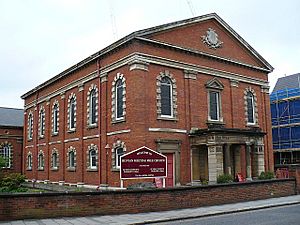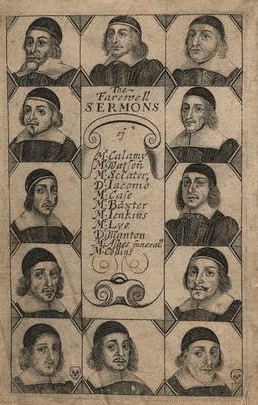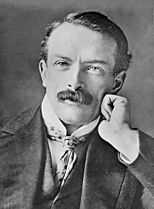Nonconformist (Protestantism) facts for kids
In English church history, Nonconformists were Protestant Christians who chose not to follow the rules and ways of the official state church, the Church of England (Anglican Church).
The term became common in England after the Stuart monarchy returned in 1660. This was when the Act of Uniformity 1662 made people oppose changes within the Church of England even more. By the late 1800s, the term included other Reformed Christian groups like Presbyterians and Congregationalists. It also included Baptists, Brethren, Methodists, and Quakers. Earlier groups, like the Puritans, who didn't follow the Act of Uniformity 1558, were later also called Nonconformists.
By law and social rules, Nonconformists faced many limits in public life. For example, they couldn't hold public jobs, work in government, or get degrees from universities. These limits were called "civil disabilities". In England and Wales in the late 1800s, new terms like "free church" and "Free churchman" started to replace "Nonconformist" or "dissenter."
Two important Nonconformist ministers were Matthew Henry and Isaac Watts. Matthew Henry started publishing his famous Bible commentary in 1710, which is still used today. Isaac Watts wrote hymns that Christians around the world still sing.
The word Nonconformist can also be used more widely. It refers to Christians who are not part of the main national church in their country, like the Lutheran Church of Sweden.
Contents
Nonconformists in England
How it Started

The Act of Uniformity 1662 made church leaders use all the ceremonies and prayers from the Book of Common Prayer. It also said that all Church of England ministers had to be ordained by bishops. This rule was very unpopular with the Puritans. Puritans were a group within the church who had become powerful during the English Civil War.
Because of this act, nearly 2,000 clergymen were "ejected" (removed) from the official church. They refused to follow the new rules. This event is known as the Great Ejection. The Great Ejection made many people aware of Nonconformity.
After this, a Nonconformist was any English person who belonged to a non-Anglican church or a non-Christian religion. More generally, anyone who supported religious freedom was often called a Nonconformist. Strict religious rules, like the Clarendon Code, stopped many English people from taking part in public life. They couldn't even get university degrees for over 150 years. Even longer, Nonconformists faced unfair treatment in English and Welsh society.
Groups like Presbyterians, Congregationalists, Baptists, Calvinists, and other "reformed" groups were called Nonconformists in 1662. Later, other groups like Methodists, Unitarians, Quakers, Plymouth Brethren, and English Moravians were also officially called Nonconformists as they became organized.
The term dissenter became especially common after the Act of Toleration 1689. This act protected Nonconformists who swore loyalty to the king from being punished for certain things, like not attending Church of England services.
A religious survey in 1851 showed that Nonconformists made up about half of the people who went to church on Sundays. In larger factory towns, Nonconformists clearly outnumbered members of the Church of England.
Nonconformist Beliefs and Values
Nonconformists in the 1700s and 1800s were known for valuing hard work, self-control, saving money, and trying to improve their lives. Historians today mostly agree with this view.
Women's Roles
In the middle class, women were expected to stay in the home. They were supposed to focus on family, husband, children, household, religion, and good behavior. Religion was seen as a woman's area. Nonconformist churches offered new roles that women eagerly took on. They taught Sunday school, visited the poor and sick, gave out religious leaflets, and helped raise money. Some even led Methodist class meetings and prayed with other women. A few were allowed to preach to mixed groups.
Politics and Rights
Removing Restrictions
Parliament had placed many restrictions on Nonconformists. These laws stopped them from holding most public jobs. They also had to pay local taxes to the Anglican church and be married by Anglican ministers. They couldn't attend Oxford University or get degrees from Cambridge. Nonconformists demanded that these political and civil restrictions be removed. The Anglican church strongly resisted until 1828.
The Test Act of 1673 made it illegal for anyone not taking communion in the Church of England to hold a job under the King. The Corporation Act of 1661 did the same for jobs in town governments. Even though these acts were still laws, they were not usually enforced against Protestant Nonconformists. This was because of special laws called Indemnity Acts. For example, the Indemnity Act 1727 excused Nonconformists from the rules of the Test and Corporation Acts.
In 1732, Nonconformists in the City of London formed a group called the Dissenting Deputies. Their goal was to get the Test and Corporation Acts removed. This group became very good at pressuring politicians. They worked with liberal Whigs to get the acts repealed in 1828. This was a big success for an outside group.
Next, they focused on church rates. These were local taxes paid to support the local parish church building in England and Wales. Only buildings of the official church received this tax money. Some Nonconformists refused to pay, which led to their property being taken or even them being put in prison. The forced payment of church rates was finally stopped in 1868 by William Ewart Gladstone.
The issue of marriage was settled by the Marriage Act 1836. This law allowed local government officials to handle marriages. Nonconformist ministers could marry couples in their own chapels if a government official was present. Also in 1836, official records of births, deaths, and marriages were taken from local church officials and given to local government officials.
Burying the dead was a harder problem. City chapels rarely had graveyards. Nonconformists wanted to use the traditional graveyards controlled by the official church. The Burial Laws Amendment Act 1880 finally allowed this.
Oxford University required students to agree to the Thirty-nine Articles of the Church of England to be admitted. Cambridge University required this for a diploma. These two old universities opposed giving a charter to the new London University in the 1830s because it had no such rule. However, London University was still started in 1836. By the 1850s, Oxford dropped its rules. In 1871, Gladstone helped pass a law that gave Nonconformists full access to degrees and special positions at universities. The Scottish universities never had these restrictions.
Impact on Politics
Since 1660, Dissenters, later called Nonconformists, have played a big role in English politics. Historians often divide Dissenters into two groups. "Old Dissenters" from the 1500s and 1600s included Baptists, Congregationalists, Quakers, Unitarians, and Presbyterians (outside Scotland). "New Dissenters" appeared in the 1700s and were mainly Methodists.
The "Nonconformist conscience" was their strong moral belief system. They tried to bring these morals into British politics. The "Nonconformist conscience" of the Old Dissenters focused on religious freedom and equality. They also wanted justice and opposed unfair treatment. Both groups were active in politics. But until the mid-1800s, the Old Dissenters mostly supported Whigs and Liberals. The New Dissenters, like most Anglicans, generally supported Conservatives. By the late 1800s, most New Dissenters had switched to the Liberal Party. This brought the two groups together, making them a very strong political force.
After the Test and Corporation Acts were removed in 1828, all Nonconformists elected to Parliament were Liberals. While not many Members of Parliament (MPs) were Dissenters, they were a major voting group in many areas. They were very organized and motivated. They largely convinced the Whigs and Liberals to support their causes. Gladstone convinced most Dissenters to support Home Rule for Ireland. This created an unusual alliance between Protestant Dissenters and Irish Catholics. Gladstone also often asked the Nonconformist conscience for support for his moral foreign policy. In many elections, Protestant ministers encouraged their church members to vote Liberal. (In Scotland, Presbyterians played a similar role to Nonconformists in England and Wales.) Many of the first MPs elected for the Labour Party in the 1900s were also Nonconformists.
Nonconformists were very angry about the Education Act 1902. This law used taxes to support denominational schools (schools linked to a specific church). The elected local school boards that Nonconformists largely controlled were removed. They were replaced by county-level local education authorities that were usually controlled by Anglicans. Worst of all, the Anglican schools they disliked would now get money from local taxes that everyone had to pay.
One way Nonconformists fought back was by refusing to pay local taxes. John Clifford started the National Passive Resistance Committee. By 1904, over 37,000 demands for unpaid school taxes were sent out. Thousands had their property taken, and 80 protesters went to prison. This protest continued for another ten years but did not change the school system. The education issue played a big part in the Liberal victory in the 1906 general election. Many Dissenter Conservatives voted Liberal to punish their old party. After 1906, the Conservative-controlled House of Lords blocked a Liberal attempt to change the law. After 1911, when the Lords lost their power to stop laws, the issue was no longer a top priority for the Liberals.
By 1914, the link between Nonconformists and the Liberal Party was getting weaker. This was because secularization (people becoming less religious) reduced the power of Dissent in English politics.
Today
Today, Protestant churches that are independent of the Anglican Church of England or the Presbyterian Church of Scotland are often called "free churches." This means they are free from state control. This term is used in the same way as "Nonconformist."
The speed of people becoming less religious increased during the 1900s. Now, only small groups of Nonconformist religious activity remain in England.
Nonconformists in Wales
Nonconformity in Wales started with the Welsh Methodist revival. Wales became a Nonconformist country by the mid-1800s. Many more people attended Nonconformist chapels than Anglican churches. These churches were strong among the growing middle class in cities.
The influence of Nonconformism in the early 1900s, boosted by the 1904–1905 Welsh Revival, led to the official separation of the Anglican Church in Wales in 1920. This created the Church in Wales.
In other countries, the term Nonconformist is used more broadly. It refers to Christians who are not part of a majority national church, such as the Lutheran Church of Sweden. The largest Nonconformist church in Sweden, the Uniting Church in Sweden, was formed by joining the Baptist Union of Sweden, United Methodist Church, and Mission Covenant Church of Sweden.
See also
- English Dissenters
- English Presbyterianism
- Christian revival
- Independent (religion)
- Nonconformist register – records of baptisms, weddings and funerals kept by chapels
- Recusancy
- Religion in the United Kingdom




